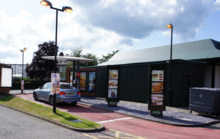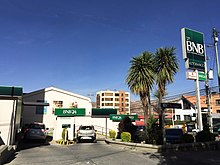Drive-through
However, during peak periods, to keep the queue down and avoid traffic flow problems, drive-throughs occasionally switch to an "order at the window, then park in a designated space" model where the customer will receive their food from an attendant when it is ready to be served.Most drive-through lanes are designed so the service windows and speaker are on the driver's side of the car, for example, in left-hand traffic (right-hand drive) countries such as the UK, Ireland, Australia, India and New Zealand, the windows will be on the right side of the drive-through lane, and vice versa in right-hand traffic (left-hand drive) countries such as North America and mainland Europe.[2] According to QSR's 2024 annual survey, Taco Bell was the fastest fast-food chain in the United States regarding drive-thru service time, with an average wait of 194.16 seconds.[citation needed] In 2010, the Casa Linda, Texas, franchise of McDonald's opened a drive-through/walk-up-only store with no indoor seating although it has a small patio with tables.[citation needed] Shortly after the Grand National Bank in St Louis opened up a drive-through, including a slot to the side for night time deposits.[citation needed] Alcoholic beverages have been sold at a drive-through liquor store (called a "Beer Through", a "Cruise Through", a "Brew Thru" in the U.S. eastern Mid-Atlantic coast,[17] or a "Pony Keg" or "Party Barn" in certain areas; generally illegal in the Northeast and West) During the COVID-19 pandemic, drive-through testing became a common approach around the world for testing people who were potentially infected with the virus.[25] If the average motorist avoided idling for just 3 minutes every day of the year, CO2 emissions would be reduced by 1.4 million tonnes annually, or the equivalent of taking 320,000 cars off the road.[31] Long drive-through lines in the United States have been reported to cause traffic backups, blocking emergency vehicles and city buses and increasing the risk of collisions and pedestrian injuries.[42] Since the COVID-19 pandemic an increasing number of restaurants, including bakeries and pizzerias, have introduced sliding windows that are licensed by the local municipality for customer transactions.[42] Another reason is to offer extended service hours and maintain a safe environment for employees, such as a bulletproof walk-up window in high-crime areas.[46] On 20 July 2013, a woman was fined for taking her horse inside a McDonald's restaurant in Greater Manchester, United Kingdom, after being refused service at the drive-through.[51] The Willamette Week tested five locations, and in all cases customers without cars received satisfactory service: McDonald's first opened a ski-through called McSki in the ski resort of Lindvallen, Sweden, in 1996.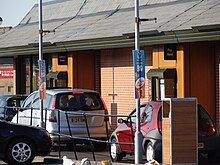
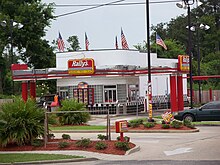
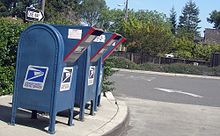


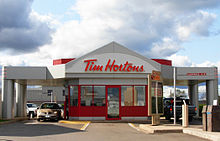
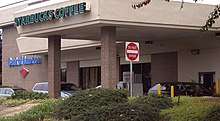

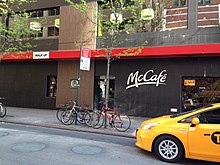
Drive-through (disambiguation)United KingdomRally'sNew OrleansLouisianamailboxesLos AltosCaliforniaUnited Statessensational spellingtake-outSt. Louis, Missourimicrophonedrive-incarhoptraffic flowfast food chainsMcDonald'sintercomEdinburghspeakerheadsetarmed robberyespressoTim HortonsMonctonleft-hand trafficTaco BellChick-fil-AKirby's Pig StandcarhopsRed's Giant HamburgSpringfield, MissouriIn-N-Out BurgerSierra Vista, ArizonaFort HuachucafatiguesMax HamburgersPiteåNutgrove Shopping CentreLa PazUMB Financial CorporationR. Crosby KemperWestminster BankUlster Bankautomated teller machinesgrocery shoppingAlbert HeijnSkinner DairyDairy BarnLong IslandliquorCOVID-19 pandemicCOVID-19climate changeRock N Roll McDonald'sLas VegasFuneral homePennsylvania State RepresentativeKevin P. MurphyPhoto processingFotomatChristmas lightsBurgervillemobile kitchenskiosksconcession standsGreater Manchesterclass actionvisually impairedPortland, OregonB-Bop'sDisposable food packagingEffects of the car on societiesOxford University PressQuartz (publication)The GuardianKyodo News AgencyJapan TimesFast foodConvenience foodJunk foodSnack foodStreet foodFast food restaurantFood boothFood cartFood courtFood truckBreakfast sandwichBreakfast sausageBuffalo wingsCheeseburgerChicken fingersChicken nuggetsCookieFrench friesFrench toastFried chickenGrilled cheeseGyūdonHamburgerHot dogHot pretzelIce creamMacaroni and cheeseOnigiriOnion ringsPancakesPeanut butter and jelly sandwichSausageSpaghettiWafflesCriticism of fast foodFast food advertisingFood desertFast cultureConsumerismConvenience storeFast fashionFood deliveryOnline food orderingInstant gratificationOverconsumptionPlanned obsolescenceSame-day delivery
